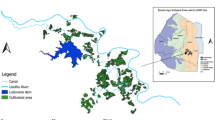Abstract
There is a general contention among scholars that first, wheat–paddy cropping pattern is largely responsible for declining ground water table in Punjab and secondly, that the wheat–paddy cropping system is becoming unsustainable over time as the yield levels of these two major crops are stagnating. However, the existing evidences do not throw adequate insight into the stage of groundwater depletion during which the wheat–paddy cycle becomes unsustainable. The paper strengthens the existing empirical base of sustainability status of this cropping cycle in Punjab. A comparison of irrigation systems in terms of both trends in yield and stability for wheat and paddy has been attempted to arrive at a holistic appraisal of sustainability aspects of crop specialization in Punjab. It is observed that the canal dependent irrigation system has performed better as compared to the overexploited groundwater irrigation system in terms of most of the parameters used in the study.




Similar content being viewed by others
Notes
In 1960–1961, area under wheat was 30% of the gross cropped area.
The method used to derive the crop combination regions is the Weaver’s Method (Weaver 1954).
It is also to be noted that Kapurthala is the traditional rice growing district of the state (Singh and Grover 1991).
It is expected that rice is being supported by tube-well irrigation even in Faridkot, where during the decades of eighties and nineties, canal was the main source of irrigation. This argument is strengthened by the fact that the increase of area under paddy in the district closely follows the trend of increase of well irrigation.
A deeper investigation probably at the household level could explain the relative yield position of Amritsar. Factors as variety of seed, quality of irrigation, methods of cultivation are important in explaining yield levels.
All the blocks in Kapurthala have been over-exploited i.e. more than 100% of its potential.
References
Chadha, G. K., Sen, S., & Sharma, H. R. (2004). Land resources, state of the indian farmer: a millennium study. Vol. 2, New Delhi: Ministry of Agriculture, GOI, Academic Foundation.
Chambers, R., & Conway, G. (1992). Sustainable rural livelihoods: practical concepts for the 21st century. IDS Discussion Paper no. 296 (6 pp.). Brighton, UK: Institute of Development Studies, University of Sussex.
Chopra, K. (1993). Sustainability of agriculture. Indian Journal of Agricultural Economics, 48(3), 527–535.
Conway, G. (1986). Agro-ecosystem analysis. Agricultural Administration, 20, 31–55.
Costanza, R., & Daly, H. E. (1992). Natural capital and sustainable development. Conservation Biology, 6(1), 37–46.
Crosson, P. (1990). Arresting renewable resource degradation in the third world: Discussion. American Journal of Agricultural Economics, 72(5), 1276–1277.
Dhawan, B. D. (1982). Development of tubewell irrigation in India. New Delhi: Agricole Publishing Academy.
Jodha, N. S. (1991). Sustainable agriculture in fragile resource zones: Technological imperatives. Economic and Political Weekly, 26(13), A-15–A-26.
Johl, S. S. (1986). The future of agriculture production in Punjab. Man and Development, 8(4), 107–119.
Kaul, J. L., & Sekhon, S. (1991). Flexibility and reliability of irrigation systems and their effect on farming–a case of Punjab. Indian Journal of Agricultural Economics, 46(4), 587–592.
Kaur, M., & Sekhon, M. K. (2005). Input growth, total factor productivity and its components in Punjab agriculture: District-wise analysis. Indian Journal of Agricultural Economics, 60(3), 473–482.
Kumar, P. et al. (1998). Sustainability of rice wheat based cropping system in India: Socio-economic and policy issues. Economic and Political Weekly, 76(2), A-152–A-158.
Prihar, S. S. et al. (1990). Water resources of Punjab: A critical concern for the future of its agriculture. Punjab: Punjab Agricultural University, Ludhiana.
Redclift, M., (1992). Sustainable development: Exploring the contradictions. London: Routeledge.
Sidhu, D. S. et al. (1999). An economic analysis of various sources of irrigation in Punjab. Indian Journal of Agricultural Economics, 26(1), 506–511.
Sidhu, R. S., & Sukhpal, S. (2003). Economic sustainability of wheat and rice crops in Punjab: Issues on prices, profitability and natural resource use. Indian Journal of Agricultural Economics, 58(3), 387–390.
Singh, B. (1992). Groundwater resources and agricultural development strategy: Punjab experience. Indian Journal of Agricultural Economics, 47(1), 105–113.
Singh, S. (1991). Some aspects of groundwater balance in Punjab. Economic and Political Weekly, 26(52), A-146–A-155.
Singh, J., Grover, D. K. (1991). The impact of technological advance on inter-regional disparities in land use and farm incomes in Punjab. Indian Journal of Agricultural Economics, 46(3), 440–444.
Weaver, J. C. (1954). Crop combination regions in the middle-west. Geographical Review, XLIV(2), 173–200.
Wolff, P. (1995). The problem of the sustainability of irrigation systems. Applied Geography and Development, 45/46, 55–62.
Author information
Authors and Affiliations
Corresponding author
Additional information
Readers should send their comments on this paper to: BhaskarNath@aol.com within 3 months of publication of this issue.
Rights and permissions
About this article
Cite this article
Sarkar, A., Sen, S. & Kumar, A. Rice–wheat cropping cycle in Punjab: a comparative analysis of sustainability status in different irrigation systems. Environ Dev Sustain 11, 751–763 (2009). https://doi.org/10.1007/s10668-008-9141-8
Received:
Accepted:
Published:
Issue Date:
DOI: https://doi.org/10.1007/s10668-008-9141-8




